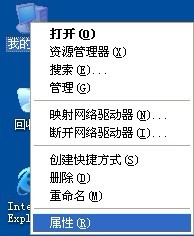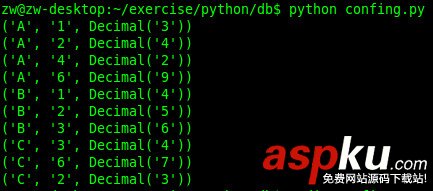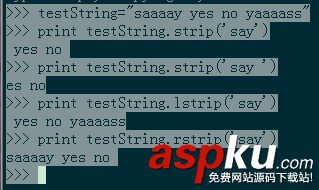1.入門
首先你得用過C/C++、java、Javascript等的一種,編程小白估計(jì)比較艱難,有一定編程經(jīng)驗(yàn)的python小白相對(duì)簡(jiǎn)單些。
1.1 Hello World!
Python安裝比較簡(jiǎn)單,到官網(wǎng)上下載安裝包,一路下一步就可以了。因?yàn)槲业姆?wù)器上安裝的是2.6.6,所以我也下了這個(gè)版本。話說2.x的差別不是很大,如果想用3.x,可能下面的代碼直接運(yùn)行不過,不過也差不多,稍微改改即可。
新建一個(gè)文件,命名為hello.py。使用python的IDLE打開hello.py,寫入以下代碼:
print "Hello World!"
按F5,就可以看見輸出結(jié)果了。
1.2 基本語法
每一行是一條語句。C語言是通過分號(hào)”;“;
通過縮進(jìn)來組織代碼塊。C語言是通過大括號(hào)”{}“;
注釋使用井號(hào)”#“。
1.3 數(shù)據(jù)類型、運(yùn)算符、數(shù)據(jù)結(jié)構(gòu)
運(yùn)算符和C語言差不多,C語言有的基本上直接用就可以。
數(shù)據(jù)類型有數(shù)值型,字符串。數(shù)據(jù)結(jié)構(gòu)有 list, tuple, dict, set。介紹一下tuple, 不能修改,通過索引進(jìn)行查找。dict類似于map,存放鍵值對(duì)。來看例子,看看tuple使用:
>>> t=(1,2,[1,2])>>> t[2][1, 2]
1.4 流程控制
Python中可以使用if elif else、for和 while 來實(shí)現(xiàn)流程控制。同樣有 break 和 continue。有一點(diǎn)和C不同,如果有一個(gè)分支什么都不做,要使用 pass。例如
list=[0, 1, 2, 3, 4, 5]for item in list: if item == 1: print item elif item in (2, 3, 4, 5): print "aha " + str(item) else: pass
運(yùn)行結(jié)果是:
1
aha 2
aha 3
aha 4
aha 5
1.5 模塊組織
有方法和類。
方法這樣定義
def func(var): some code here
類和C++等有些不同
class MyClass(object): common = 1 def __init__(self): self.myvariable = 5 def myfunction(self, arg1, arg2): return self.myvariable
common變量相當(dāng)于C++中用 static 修飾的變量,所有類通用;繼承也非常簡(jiǎn)單,可以看看開始推薦的那篇文章。
1.6 異常處理
異常處理非常簡(jiǎn)單,直接貼代碼了:
def some_function(): try: # Division by zero raises an exception 10 / 0 except ZeroDivisionError: print "Oops, invalid." else: # Exception didn't occur, we're good. pass finally: # This is executed after the code block is run # and all exceptions have been handled, even # if a new exception is raised while handling. print "We're done with that."
1.7 工程組織
直接引用庫(kù),或者從庫(kù)中引入某一個(gè)方法或變量。
import randomfrom time import clock
2. 數(shù)據(jù)庫(kù)查詢
既然是監(jiān)控,免不了和數(shù)據(jù)庫(kù)打交道。我使用的是PostgreSQL,所以就介紹一下python怎么調(diào)用postgres。
連接postgres首先要安裝一個(gè)庫(kù)psycopg2,Windows下直接下載安裝即可,注意選對(duì)版本。我的服務(wù)器是CentOS,安裝直接運(yùn)行
yum install python-psycopg2
就OK了。
2.1 首先創(chuàng)建數(shù)據(jù)庫(kù)連接
#get database connectdef get_con(): host = '127.0.0.1' port = "5432" database = 'platform' user = 'postgres' password = 'postgres' conn = psycopg2.connect(database=database, user=user, password=password, host=host, port=port) return conn
2.2 執(zhí)行SQL語句
#執(zhí)行sql查詢def query(conn, sql): cursor = conn.cursor() cursor.execute(sql) results = cursor.fetchall() #close cursor cursor.close() return results
2.3 然后就可以寫具體業(yè)務(wù)了
def getUsers(): conn = get_con()#open connect sql = """select * from t_user order by intime DESC limit 5""" items = query(conn , sql) print str(items) conn.close() #close connect
注意3個(gè)引號(hào)”””,就是普通字符串,不過可以換行。
3. 發(fā)送郵件
查詢到數(shù)據(jù)之后不能及時(shí)通知管理員的話監(jiān)控就沒有意義了。所以我們通過郵件來通知,直接使用python的標(biāo)準(zhǔn)庫(kù) smtplib 就可以了。寫個(gè)發(fā)送郵件的函數(shù):
#發(fā)送郵件def send_email(subject, content): sender = "yourmail@***.com" password = "******" #密碼是看不見的哦 receivers = [tq8117179#163.com] #本人真實(shí)郵箱,歡迎發(fā)郵件討論技術(shù)問題 host = "smtp.exmail.qq.com" port = 465 msg = MIMEText(content,'html','utf-8') msg['From'] = sender msg['To'] = ",".join(receivers) msg['Subject'] = Header(subject, 'utf-8') try: smtp = smtplib.SMTP_SSL(host, port) smtp.login(sender, password) smtp.sendmail(sender, receivers, msg.as_string()) except Exception, e: logger.error(e) logger.info(content)
4.日志
發(fā)送郵件時(shí)我們使用了logger,這個(gè)logger是怎么來的呢?新建一個(gè)log.py,代碼如下
# coding=utf-8import loggingimport logging.handlerslogger = logging.getLogger('monitor')logger.setLevel(logging.DEBUG)filehandler = logging.handlers.TimedRotatingFileHandler( "/mnt/log/monitor/monitor_log", 'midnight', 1, 7)# 設(shè)置文件后綴名稱filehandler.suffix = "%Y%m%d.log"formatter = logging.Formatter('%(asctime)s-%(name)s-%(levelname)s: %(message)s')filehandler.setFormatter(formatter)logger.addHandler(filehandler)通過logging.getLogger(‘monitor')生成一個(gè)logger,然后配置一個(gè)文件處理器。然后在我們監(jiān)控程序中引用即可:from log import logger 5. 把可配置信息放到配置文件中
如果我們添加一個(gè)管理員怎么辦?如果我們的郵箱密碼變了怎么辦?直接修改python文件啊,哈哈。python不用編譯直接改代碼就好了,可是我們的程序以后要打包呢,所以最好寫個(gè)配置文件,python的配置文件讀取非常簡(jiǎn)單,使用python庫(kù) ConfigParser 即可:
config = None#get configdef getConfig(): global config if config is None: config = ConfigParser.ConfigParser() config.read("monitor.ini") return config 然后這樣使用:
#get database connectdef get_con(): host = getConfig().get('db', 'host') port = getConfig().get('db', 'port') database = getConfig().get('db', 'database') user = getConfig().get('db', 'user') password = getConfig().get('db', 'password') conn = psycopg2.connect(database=database, user=user, password=password, host=host, port=port) return conn#發(fā)送郵件def send_email(subject, content): sender = getConfig().get('mail', 'sender') password = getConfig().get('mail', 'password') receivers = getConfig().get('mail', 'receivers').split(",") host = getConfig().get('mail', 'host') port = getConfig().getint('mail', 'port') msg = MIMEText(content,'html','utf-8') msg['From'] = sender msg['To'] = ",".join(receivers) msg['Subject'] = Header(subject, 'utf-8') try: smtp = smtplib.SMTP_SSL(host, port) smtp.login(sender, password) smtp.sendmail(sender, receivers, msg.as_string()) except: logger.exception("Exception: ") logger.info(content) 配置文件是monitor.ini,內(nèi)容如下:
#數(shù)據(jù)庫(kù)配置[db]host = 127.0.0.1port = 5432database = platformuser = postgrespassword = postgres#郵件配置[mail]sender = yourmail@XXX.compassword = ******#多個(gè)聯(lián)系人用英文逗號(hào)隔開receivers = tq8117179#163.comhost = smtp.exmail.qq.comport = 465
6. 加點(diǎn)控制
我們每5分鐘查一下數(shù)據(jù),可是業(yè)務(wù)sql只能查詢最近的幾條,所以要加個(gè)時(shí)間段限制,弄個(gè)開始、結(jié)束時(shí)間。
start_time = "2015-10-1 16:24:24"end_time = None#update end_time, invoke before get new datadef update_end_time(): global end_time now = time.mktime(datetime.now().timetuple()) end_time = time.strftime('%Y-%m-%d %H:%M:%S', time.localtime(now)) return end_time#update end_time, invoke after get new datadef update_start_time(): global start_time global end_time start_time = end_time return start_timegetUsers可以改寫成:def getUsers (conn): global start_time global end_time sql = """select * from t_user where intime>=""" +"'"+start_time+"' and intime<"+"'"+end_time+"';" items = query(conn, sql) if items is not None and len(items)>0: count = len(items) tip = "又有"+str(count)+"個(gè)用戶已經(jīng)注冊(cè)了。"+end_time send_email(tip, tip+"/n"+str(items)) 然后寫個(gè)統(tǒng)一的調(diào)度:
def task(): #init end_time and start_time, must init end_time first!!! end_time = update_end_time() start_time = update_start_time() #init config getConfig() while True: conn = get_con() #open connect end_time = update_end_time() ############## process ############## logger.info("query: "+end_time) getUsers (conn) #do some task else here ## end update_start_time() conn.close()#close connect time.sleep(5*60) #end of whiledef run_monitor(): monitor = threading.Thread(target=task) monitor.start()if __name__ == "__main__": run_monitor() 在task這個(gè)函數(shù)的while中,首先更新end_time,也就是當(dāng)前時(shí)間;執(zhí)行完再把start_time更新成剛剛的end_time,這樣就不會(huì)有漏網(wǎng)之魚了。還有一個(gè)需要注意的地方,關(guān)鍵字global。 在python中,使用全局變量是需要global關(guān)鍵字進(jìn)行聲明的,否則會(huì)出問題。
7. 運(yùn)行
打開linux 控制臺(tái),直接運(yùn)行python monitor.py是可以運(yùn)行的,可是shell一旦退出,任務(wù)也就停止了。于是我就選擇了一個(gè)進(jìn)程管理工具:Supervisor。Supervisor 在進(jìn)程中斷時(shí)還能自動(dòng)重啟。
7.1. 安裝supervisor
首先安裝python-setuptools
yum install python-setuptools
安裝supervisor
easy_install supervisor
生成supervisor配置文件
echo_supervisord_conf > /etc/supervisord.conf
然后在/etc/supervisord.conf添加:
[program:monitor]command = python /usr/monitor/monitor.pydirectory = /usr/monitoruser = root
7.2. 運(yùn)行監(jiān)控
然后在終端中運(yùn)行supervisord啟動(dòng)supervisor。
在終端中運(yùn)行supervisorctl,進(jìn)入shell,運(yùn)行status查看腳本的運(yùn)行狀態(tài)。
7.3. 關(guān)閉監(jiān)控 以及常用命令
以下命令全部在supervisorctl的shell中執(zhí)行。
- shutdown 停止Supervisor(子進(jìn)程也會(huì)被停止) ;
- start monitor 開啟monitor進(jìn)程服務(wù)(一旦monitor進(jìn)程退出,會(huì)自啟動(dòng)) ;
- stop monitor 關(guān)閉monitor進(jìn)程服務(wù) ;
- restart monitor 關(guān)閉正在運(yùn)行的monitor進(jìn)程,并且重新啟動(dòng)monitor進(jìn)程服務(wù) ;
- reload 重新加載supervisor配置文件 ;
- exit 退出supervisorctl的shell。
程序基本上就寫完了,也可以跑起來了,是不是很酷,大家快點(diǎn)動(dòng)手實(shí)踐一下吧!



















